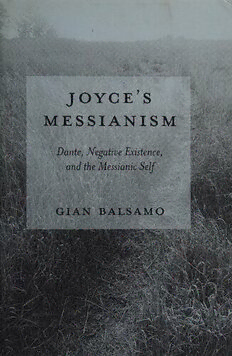
Joyce's Messianism: Dante, Negative Existence, and the Messianic Self PDF
Preview Joyce's Messianism: Dante, Negative Existence, and the Messianic Self
JOYCE'S ESSIANISM JOYCE’S MESSIANISM Dante, Negative Existence, and the Messianic Self GIAN BALSAMO n his study of negative existence and how it affects James Joyce’s principal characters, Gian .. Balsamo joins the ongoing debate about the Irish writer’s relationship to Dante and considers the cen- trality of messianism to that relationship. Finding in Dante a negative poetics that becomes a model for Joyce, Balsamo suggests that the inception and cessa- tion of life—two occurrences that conventionally are deemed impossible to experience personally and directly—typically frame the existential experiences of Joyce’s main characters. Balsamo perceives Steph- en, Leopold, and Shem as messianic figures because they rebel against this convention, clustering their lives around the very events of inception and burial. Balsamo traces the engagement of each of the three characters in a negative existence immune from the rules and limitations of ordinary experience. Each struggles to express rather than exorcise the fecun- dity of his own mortality; each reinvents his biogra- phy as involving the pivotal transaction of death— be it a mother’s, a son’s, or even that of his own body —in return for catharsis. Drawing on the writings of Giambattista Vico, Saint Augustine, Emile Durkheim, and Noam Chom- sky, Balsamo challenges the current debate by iden- tifying the messianic thread that ties together the biographies of Joyce’s three characters. Faced with the fissure between history and poetic vocation, Stephen embraces the sacrificial poetry of silence. Faced with the domestic squalor provoked by the loss of his son, Leopold renews at every meal the cathartic exchange of food and semen. Faced with a destiny of death and decomposition, Shem reenacts the tradition of the medieval cycle drama, stretching his own body like a parchment on a cross and then rubricating it like a sacred manuscript. JOYCE’S MESSIANISM edd, os Biers CF Ages,a ~ weVMaAresam 2ROvVER aan Ay braalg eee:e ah : ~ bee: a JOYCE'S MESSIANISM Dante, N egative Existence, and the Messianic Self GIAN BALSAMO abs University of South Carolina Press © 2004 University of South Carolina Published in Columbia, South Carolina, by the University of South Carolina Press Manufactured in the United States of America 08 07 06 05 04 54321 Library of Congress Cataloging-in-Publication Data Balsamo, Gian, 1949— Joyce’s messianism : Dante, negative existence, and the messianic self / Gian Balsamo. p. cm. Includes bibliographical references and index. ISBN 1-57003-552-0 (alk. paper) 1. Joyce, James, 1882—1941—Criticism and interpretation. 2. Dante Alighieri, 1265-1321— Appreciation—Ireland. 3. Joyce, James, 1882-1941—Knowledge—Literature. 4. Dante Ali- ghieri, 1265-1321—Influence. 5. Negativity (Philosophy) in literature. 6. English fiction— Italian influences. 7. Negation (Logic) in literature. 8. Messianism in literature. 9. Self in liter- ature. I. Title. PR6019.09Z52566 2004 823'.912—dc22 2004013880 To and for A.B. : i / 4 5 . 7 ie he Jame : *7 et 7 3t ‘ hae rae y ‘ i AR pee GE . ep el paying rr i=m< s | i e At oo) wRS th s Oe Sa a 7) “SE ae Pabadins; TiGea e Sona Titans a Oe cine Wilson ol oes Hoe sag Piper iu Peatten" ped 3 Gi! Td) te ef bwtigg a oe EO eee a ik s 9 he nae a ’ x elr e SS ig
